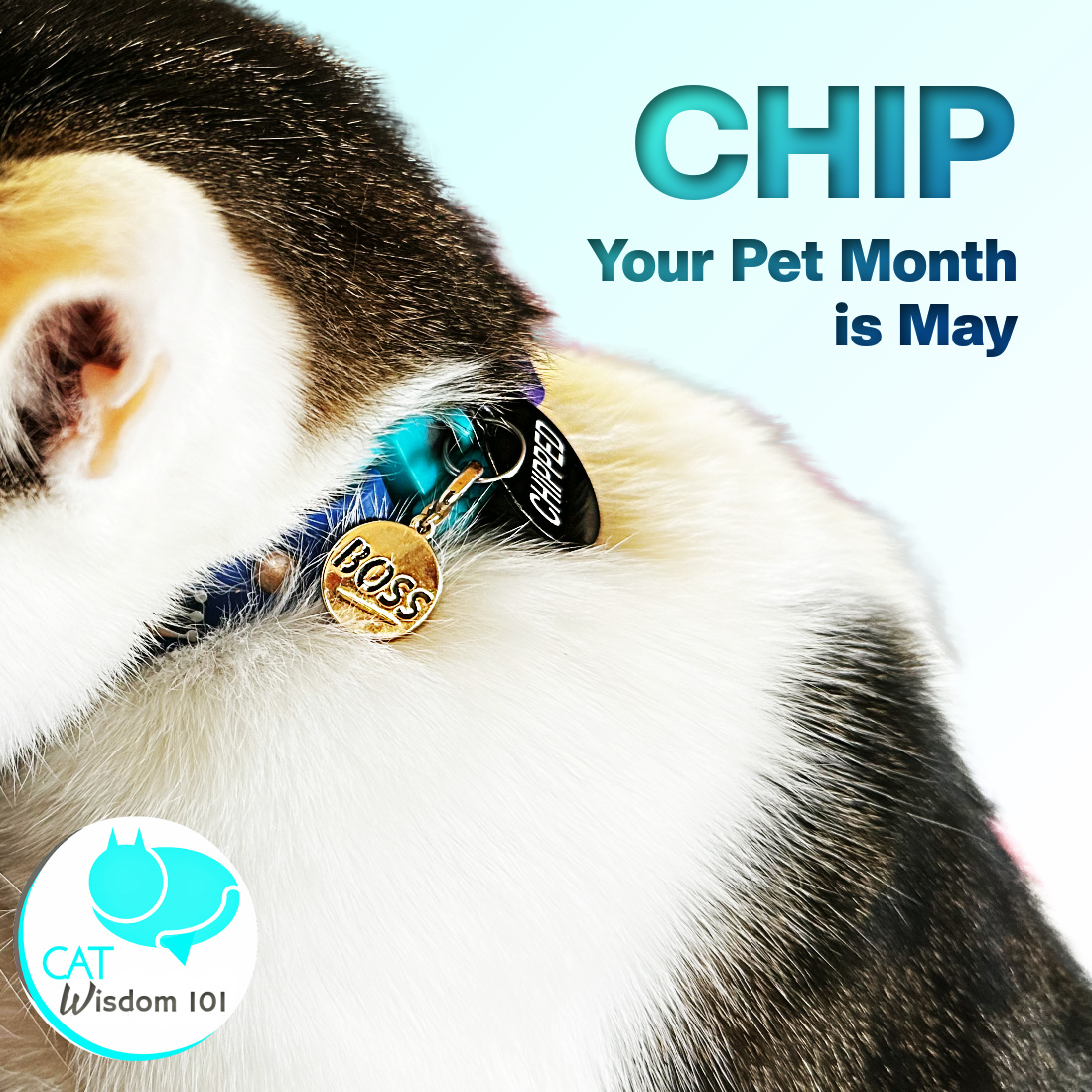
May Is Chip Your Pet Month: Why It Saves Cat Lives
May Is Chip Your Pet Month: Why Is Saves Cat Lives by Layla Morgan Wilde
Our adventure cat Odin inspired the important message of this post today.
Hey there, it’s Odin, your feline friend,
Here to remind you Chip Your Pet Month is a time to act,
And make sure we’re protected, that’s a fact,
Microchip your cat, it’s the thing to do,
It’s quick and easy, and won’t cause pain,
And if kitty gets lost you’ll both have peace of mind again.
Love, Odin

May is Chip Your Pet Month, a time to raise awareness about the importance of microchipping your pets. Microchipping is a simple and effective way to help ensure that your furry friend can be reunited with you if they ever get lost or go missing. In this article, we’ll discuss the benefits of microchipping your cat, as well as some practical tips to help ensure that your pet stays safe and secure.
Why Microchip Your Cat?
The biggest objection I hear is, “But my cat doesn’t go outside.”
Indoor cats get lost all the time. They slip outside during a party. They fall out from open windows. The escape from cars during a move or vet visit. yes, even from a closed cat carrier. It happens.
There are many reasons to microchip your cat. Here are a few of the most important ones:
- Helps reunite lost pets with their owners: One of the biggest advantages of microchipping your cat is that it can help reunite them with you if they ever get lost. A microchip is a small, electronic chip that is implanted under your cat’s skin. The chip contains a unique ID number that can be scanned by a veterinarian or animal shelter. This number is linked to your contact information in a database, so if your cat is found, you can be contacted and reunited with your furry friend.
- Provides permanent identification: Unlike collars and tags, which can be lost or removed, a microchip provides permanent identification for your cat. This is especially important if your cat is an indoor/outdoor cat or if they like to wander.
- Can save your cat’s life: If your cat gets lost and ends up in a shelter, having a microchip can make all the difference. Shelters are often overcrowded, and many animals are euthanized simply because they can’t be identified and returned to their owners. By microchipping your cat, you can help ensure that they have the best chance of being reunited with you, rather than being put to sleep.
If you’d like to dig even deeper, please read our archived post.
Everything You Ever Wanted to Know About Micro-chipping Cat
What is a microchip?
A microchip is a tiny device, about the size of a grain of rice, that is implanted under your cat’s skin. The microchip contains a unique identification number that can be read using a special scanner. This identification number is linked to your contact information, so if your cat is lost or stolen, whoever finds them can quickly contact you.
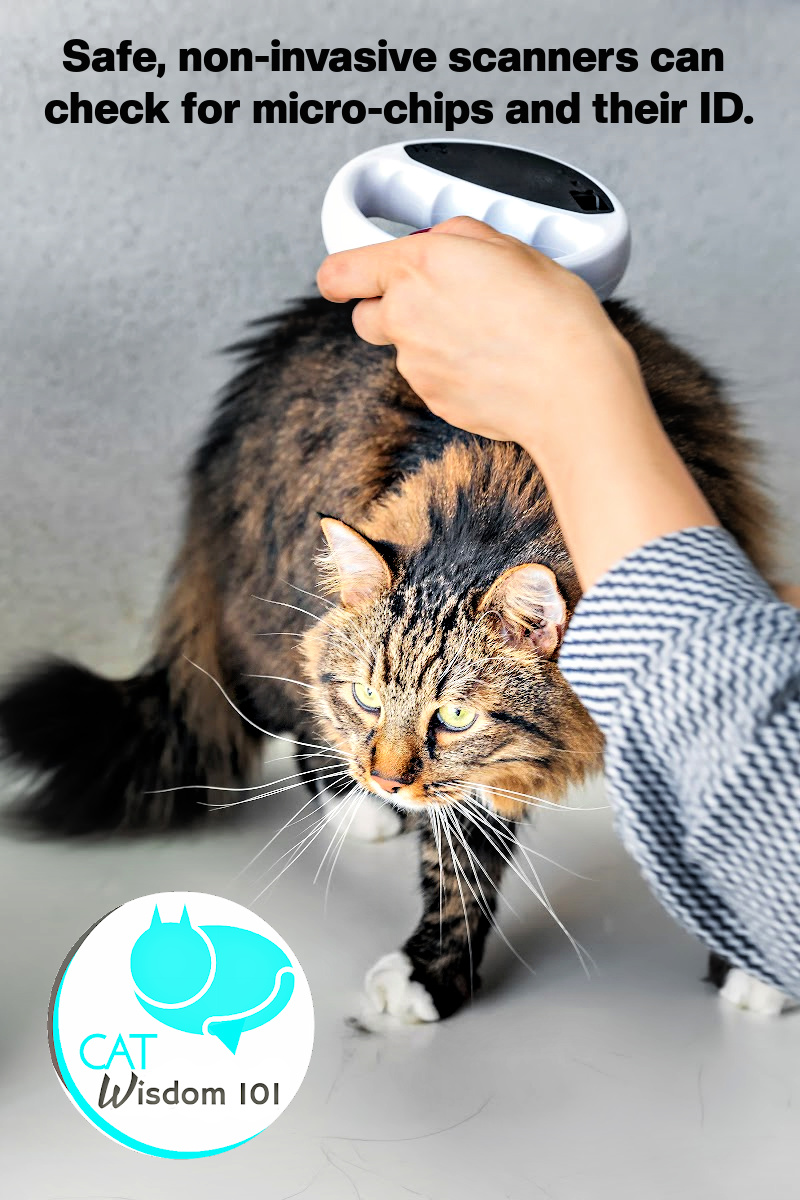
Tips for Microchipping Your Cat
If you’ve decided to microchip your cat, here are some practical tips to help ensure that the process goes smoothly:
- Talk to your vet: The first step is to consult with your veterinarian. They can help you determine if microchipping is right for your cat, and they can also perform the procedure for you.
- Prepare your cat: To prepare your cat for the microchipping procedure, make sure that they are well-rested, well-fed, and calm. You may also want to bring their favorite toy or treat to help keep them distracted and comfortable during the procedure.
- Get your cat’s information ready: Before the procedure, you will need to provide your cat’s information to the microchipping service. This includes your cat’s name, breed, age, and any other identifying information that will help the service locate your cat if they get lost.
- Follow post-procedure care instructions: After the procedure, your veterinarian will provide you with specific instructions on how to care for your cat. This may include monitoring your cat for any signs of infection or discomfort, and keeping them calm and comfortable during the recovery period.
- Choose a reputable microchip company: There are many different microchip companies out there, so it’s important to choose a reputable one. Look for a company that has been around for a while and has a good reputation. You should also make sure that the company is registered with a national database, such as the AAHA Universal Pet Microchip Lookup Tool, so that your cat’s information is easily accessible if they ever get lost.
- Keep your information up-to-date: Once your cat is microchipped, it’s important to keep your contact information up-to-date in the database. If you move or change your phone number, make sure to update your information as soon as possible so that you can be contacted if your cat is found.
- Consider getting your cat a collar and tag: While a microchip provides permanent identification, it’s still a good idea to get your cat a collar and tag with your contact information. This can help ensure that your cat is quickly identified and returned to you if they get lost.

Indoor cats can still benefit from having a microchip for the following reasons:
Accidental escapes: Even the most careful cat owners can have an indoor cat escape. Whether it’s through an open door or window, or a hole in a screen, accidents can happen. Having a microchip can provide a reliable way to identify your cat if they get lost.
Emergency situations: In the event of a natural disaster, such as a fire or earthquake, your indoor cat may become frightened and try to escape. Having a microchip can ensure that you can be quickly reunited with your cat if they get lost in an emergency situation.
Medical emergencies: If your indoor cat becomes ill and needs to be taken to a veterinary clinic, having a microchip can provide a reliable way to identify your cat and ensure that you can be contacted in case of an emergency.
BUT WILL IT HURT?
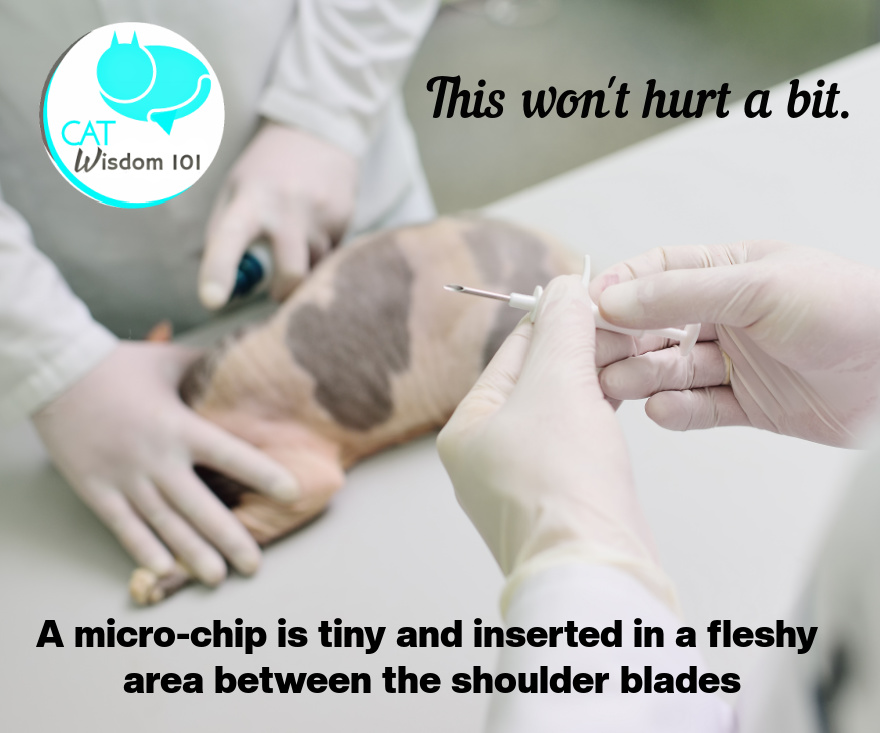
Microchipping your cat is a quick and simple procedure that can be done painlessly. In fact, most veterinarians and animal welfare organizations agree that the procedure is virtually pain-free for the cat.
A veterinarian or trained veterinary technician uses a sterile needle to inject a tiny microchip, about the size of a grain of rice, just under the skin between your cat’s shoulder blades. The procedure takes only a few seconds and your cat will likely not even notice the microchip being implanted. While the microchip itself is painless, some cats may experience minor discomfort or soreness at the injection site for a short period of time after the procedure. However, this discomfort is typically short-lived and can be managed with over-the-counter pain medication if necessary.
For fussy or delicate cats, many veterinarians will use a local anesthetic or numbing agent to minimize any discomfort during the microchipping procedure. Some clinics will apply a topical anesthetic, while others will use a local anesthetic injection at the site of the implantation to reduce discomfort.
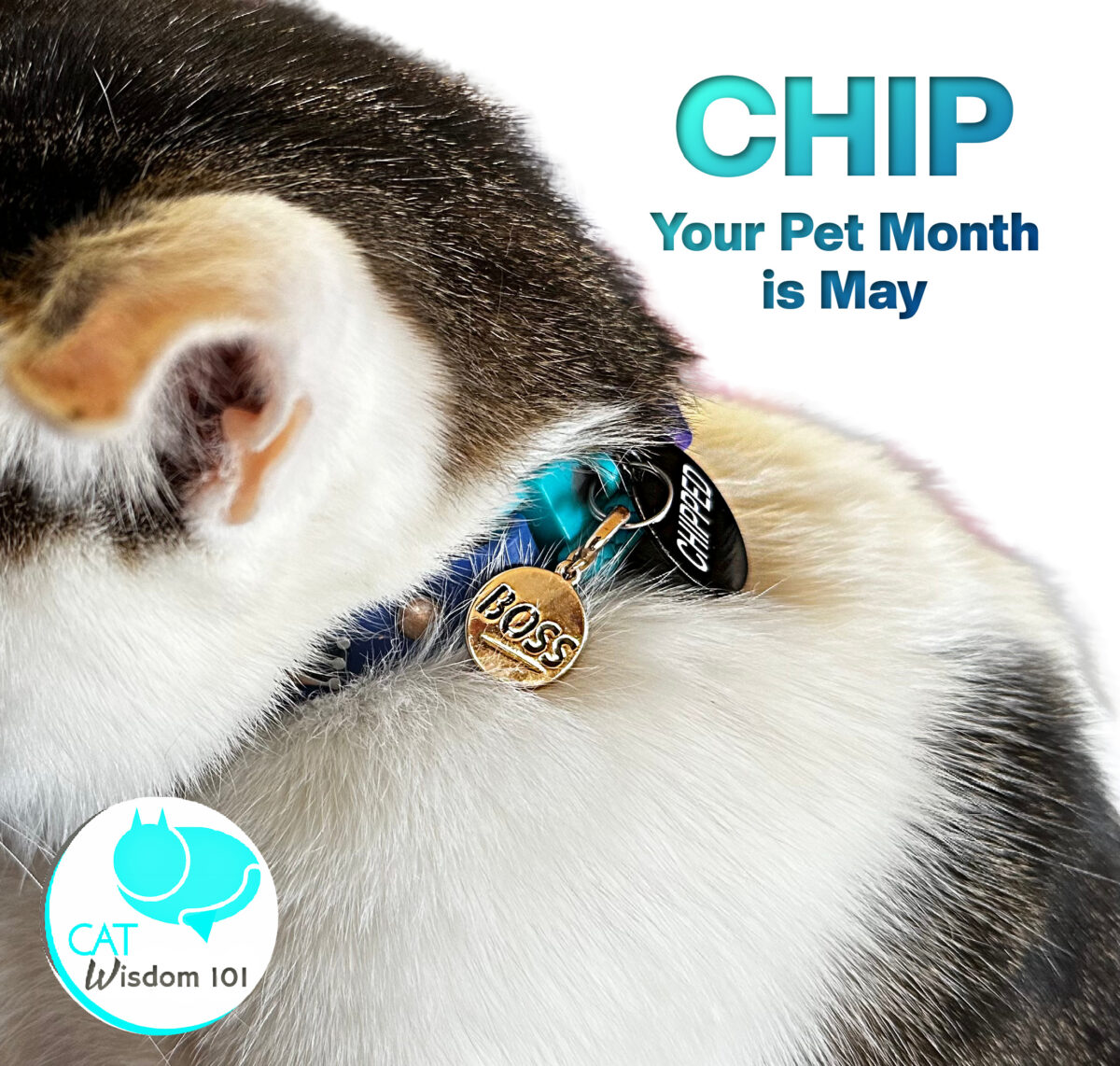
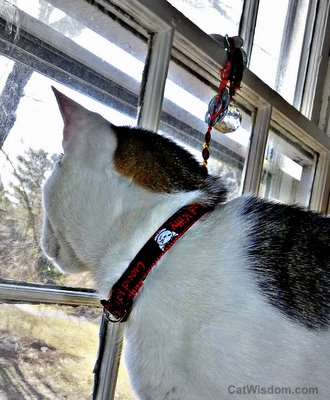
Collars and tags can be a great way to identify your cat and ensure that they can be quickly reunited with you if they get lost. However, it’s important to choose a collar and tag that are safe for your cat to wear. Here are some tips to help you choose a safe collar and tag for your furry friend:
- Choose a breakaway collar: A breakaway collar is a collar that is designed to break apart if your cat gets caught on something, such as a tree branch or fence. This is important because it can prevent your cat from getting injured or strangled if they get caught on something. Look for collars that have a release mechanism, such as a buckle that will break apart under pressure.
- Avoid collars that are too tight: It’s important to make sure that your cat’s collar isn’t too tight. A collar that is too tight can be uncomfortable for your cat, and it can also cause injury or even strangulation. You should be able to fit two fingers between the collar and your cat’s neck. Check every so often that the collar hasn’t stretched or loosened.
- Choose a lightweight tag: When choosing a tag for your cat’s collar, make sure to choose a lightweight tag. A heavy tag can be uncomfortable for your cat to wear and can also cause the collar to hang too low. Look for tags that are made from lightweight materials, such as aluminum.
- Include your contact information: Your cat’s tag should include your contact information, such as your name and phone number. This will ensure that if your cat gets lost, whoever finds them can quickly contact you. You can also include your cat’s name on the tag if you wish.
- Consider a reflective tag: If your cat goes outside at night, consider choosing a reflective tag. This will make your cat more visible to cars and other people, which can help prevent accidents and ensure that your cat is quickly found if they get lost.
- Replace tags regularly: Finally, it’s important to replace your cat’s collar and tags regularly. Collars and tags can become worn and damaged over time, which can make them less effective at identifying your cat. Make sure to check your cat’s collar and tags regularly and replace them if they are showing signs of wear or damage.
By following these tips, you can help ensure that your cat’s collar and tags are safe and effective at identifying them if they get lost or stolen. There is a shocking amount of purebred or designer dogs stolen these days. The number of cats stolen is rare but it does happen.

So if you think your cat doesn’t need to be chipped, listen to Odin think again. By following these tips, you can help ensure that your furry friend is always able to find their way back home. Happy Chip Your Pet Month!
A microchip may seem small,
But it can make a big difference to all,
So don’t wait until it’s too late,
To chip your feline mate.
Please leave your thoughts in the comments.
xo, Layla and Odin



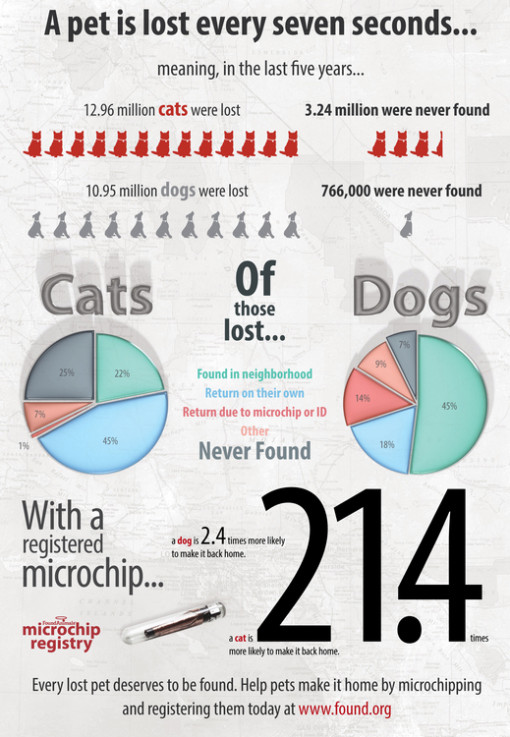



9 Comments
Brian Frum
Most of us here are chipped too and that’s a good thing!
Ellen J Pilch
Thank you for the reminder of the importance of microchipping.
Memories of Eric and Flynn
Unlike dogs, cats have not had to be microchipped in the UK. The Cats Protection of whom I am a member has long fought to get it made law . In March it was announced it will be a legal requirement from June 2024 for all cats to be chipped by the time they are 20 weeks old. There is no minimum age, that is the maximum. Failure to do so will carry a £500 fine. I hope all owners do so, not just the responsible ones who have most likely already had it done.
Layla Wilde
That’s fantastic news!
Amy Harlib
Astor-kitty is chipped and so were all of his predecessors going back to the dawn of the procedure even though all my cats were and are indoor NYC apartment dwellers that never roam outdoors.
Layla Wilde
Yes, we’re pretty about microchipping in New York State. All shelter pets are microchipped before being adopted out.
Erin the Literary Cat
Totally agree. It is now law in the UK for cats over a certain age to be chipped. I think maybe we should chip humans too, at least so I know which room Mrs H is hiding in so she can’t feed me more treats🙂
Layla Wilde
Ha, yes! I didn’t know about the age for microchipping in the UK.
Meezer'sMews&TerrieristicalWoofs
We’re hip,
Cause,
We gotta chip!